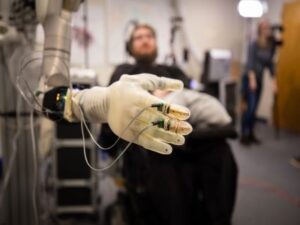
Breakthrough Published in Nature Medicine
A study published in Nature Medicine detailed how the participant, who was paralyzed in all four limbs due to a spinal cord injury, controlled the virtual drone by imagining the movement of different finger groups. The research used electrodes implanted in his left motor cortex, which had been placed during a prior surgery in 2016. Scientists trained algorithms to decode neural signals corresponding to imagined movements of his right thumb, specific finger pairs, and their combinations.
Initially, the participant practiced by synchronizing his imagined movements with a virtual hand on a screen, achieving remarkable accuracy, hitting up to 76 targets per minute. Once proficient, his brain signals were linked to the drone’s navigation system, allowing him to steer it through a virtual basketball court, maneuvering through rings with precision.
Expert Insights on Future Applications
Matthew Willsey, a neurosurgeon at the University of Michigan and co-author of the study, explained to Nature Medicine that the participant compared the experience to playing a musical instrument, requiring fine-tuned adjustments for smooth control. Willsey emphasized that the research aims to enable multi-movement control, which could help individuals perform tasks like typing or playing an instrument.
John Downey, a BCI researcher at the University of Chicago, described the study as a crucial step in understanding hand control mechanisms. He highlighted the potential of this technology as a versatile tool for people with limited mobility. Researchers now aim to refine the system to interpret signals from all ten fingers, further expanding its capabilities.
